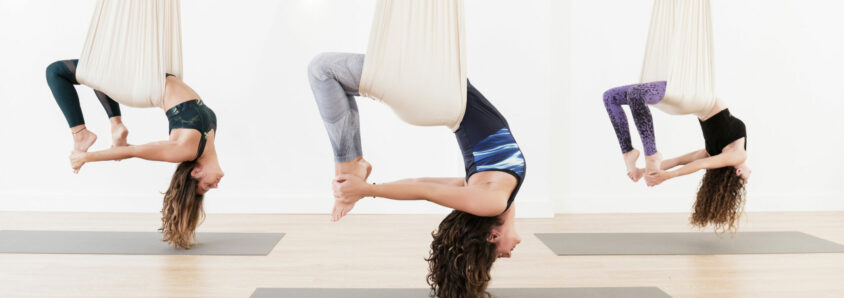More than 80,000 people perform gymnastics professionally, annually, and that number is always growing. One common form of gymnastics that’s become more popular is aerial arts and dance. Aerial arts – or aerial silks – is a difficult and challenging art form to master.
With such difficulty, it’s crucial for instructors to take every precaution. We’re happy to present a list of tips for teaching aerial arts for your client to understand.
7 Tips for Aerial Arts Instructors To Protect Themselves From Liability
Instructing in aerial arts is difficult and safety must be at the forefront of any lesson. These tips for aerial arts instructors are vital but far from extensive.
Take these tips and do your best to help your clients understand them. However, know that these 7 tips aren’t the only things to keep in mind. An aerial arts instructor should never stop studying to improve their safety.
1. Know Common Injuries
The first step in safety is to know what to look out for. Knowing what sorts of injuries commonly occur can help an instructor avoid nasty situations.
For example, a sports coach may have a list of warning signs for common problems. Heat exhaustion, overexertion, and physical injuries may appear more often in their sport.
An aerial arts instructor should know what injuries are common in aerial arts. Here’s a small list of some of the most common injuries:
- Overuse of shoulders and back
- Pulled or strained muscles
- Bruises from strain or impact
- Fabric burns from the silks
- Dizziness and nausea from spinning
- Disorientation and vertigo
- Falling from a dangerous height
Specific routines may have more specific problems. A routine that involves frequent spinning will make dizziness or disorientation more likely. Instructors should analyze their routines and training regimens to enhance safety.
2. Avoid Baggy Clothes
Another crucial step is to avoid baggy clothes while training on aerial silks. Baggy clothes can easily become snagged or caught up in the silks.
When this occurs, it becomes more difficult to safely practice one’s routine. Their spinning may lead to their clothing restricting or twisting them. A shirt drawn too tightly can cause choking or cut off circulation.
Baggy clothes also more regularly cause the silks to tangle. When silks tangle, they may come untied or cause the trainee to fall.
Instructors should set up a dress code early on in their training regimen. It’s a good idea to stick to sports clothes and tight-fitting clothing when possible.
A dress code is also great protection from lawsuits. If a trainee is injured because they ignored the dress code, it can help the trainer in court. By establishing a safety code early on, trainers are safer when their clients disregard safety.
3. Dress Safely
There’s more to dressing safely than avoiding baggy clothes. Several other factors can affect whether an outfit is safe.
One great idea is to wear clothes that can help against common injuries. For example, fabric burns are one of the most frequent injuries in aerial art. The aerial silks can rub or cause friction against a trainee’s skin, causing irritation or burning.
Clients could avoid this situation by making sure their dress code covers this situation. Longer sleeves, long pants, or clothes made of certain materials may help.
As before, these are great insurance for aerial instructors that deal with clients. If safety rules are established early, it helps to avoid injured trainees.
4. Don’t Let Anything Snag
Continuing with the issue of clothing, baggy clothes aren’t the only things that can snag. Trainers should have an eye out for any accessories that can cause snagging.
Jewelry is the most frequent problem for snagging. Earrings, bracelets, nose piercings, lip piercings, and other such accessories can become snagged in silks.
When these items snag in the silks, they are often torn out or twisted. A caught bracelet may sprain a wrist, or a lip piercing may tear or rip the skin.
These injuries also cause a biohazard. It isn’t safe for a trainee to bleed or leave bodily fluids in an area. Such a situation will require extensive sanitation.
Clients should discuss these injuries with their liability insurance provider. In the meantime, they should work to ban jewelry, zippers, accessories, and other such items.
5. Know When To Stop
Trainers need to look for more than clothing hazards! Knowing when to stop is also an important trait.
Athletes are human, and beginner trainees are exceptionally susceptible to straining themselves. Overworking a trainee can lead to exhaustion, overexertion, muscle strain, and more.
These injuries are common and can lead to liability suits. If a trainee feels they were forced to overwork, they may claim negligence.
Trainers should know when to stop pushing their trainees. Recognizing the signs of overexertion can avoid a severe injury.
6. Keep the Area Padded
Falling from the silks is a frequent cause of injury. It’s easy to make a simple mistake and become unwoven from the aerial silks.
Trainers should keep the area beneath the practice silks padded. By keeping the area padded, falls are much safer.
Without padding, trainees may fall onto a hardwood floor or worse. Putting down a few safety cushions will make falls embarrassing or frustrating instead of dangerous.
7. Check Insurance Policies
Finally, trainers should understand how liability insurance works and what theirs covers. Insurance policies are crucial for any workplace.
Knowing what an aerial arts insurance policy covers can help make any emergency situation less stressful. It’s not uncommon for trainees to sue if they feel negligence or neglect has taken place.
Make sure your clients understand what their insurance plan covers. Understanding these factors will help keep stress and panic down during bad situations.
Safely Teaching Aerial Arts
Our tips for teaching aerial arts will help to keep injuries and accidents to a minimum. It’s important to discuss insurance policies with your client to ensure they’re aware of what they’re covered for. Above all else, practicing safety will help avoid any emergency situations.
To learn more, you can request a quote or contact us at 800-257-5590 and quotes@primeis.com.


